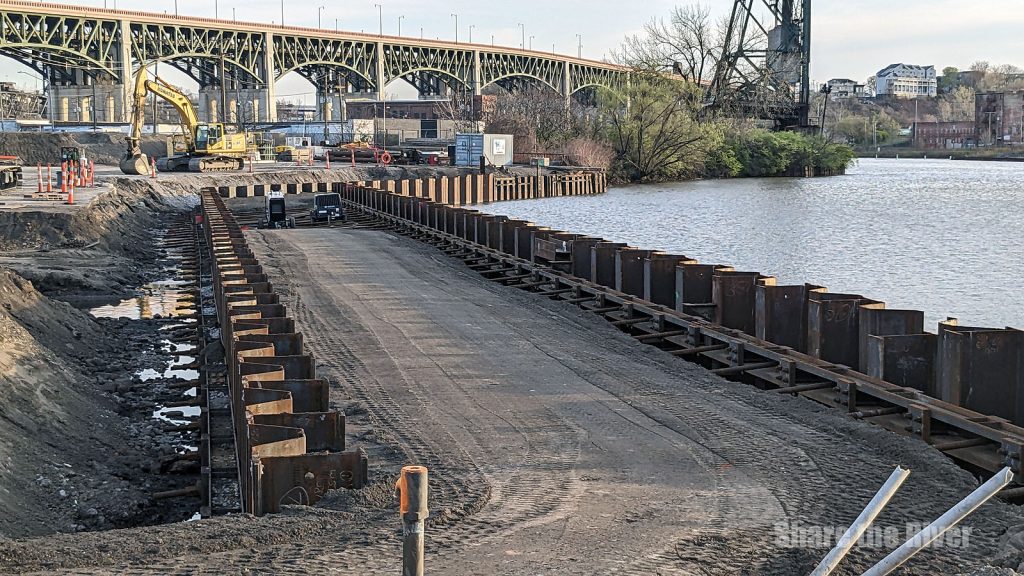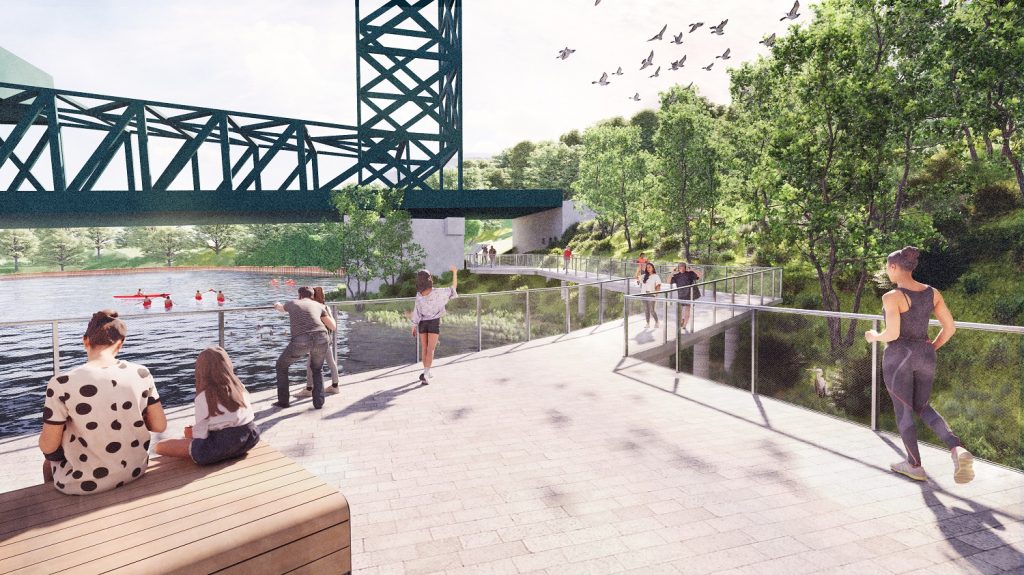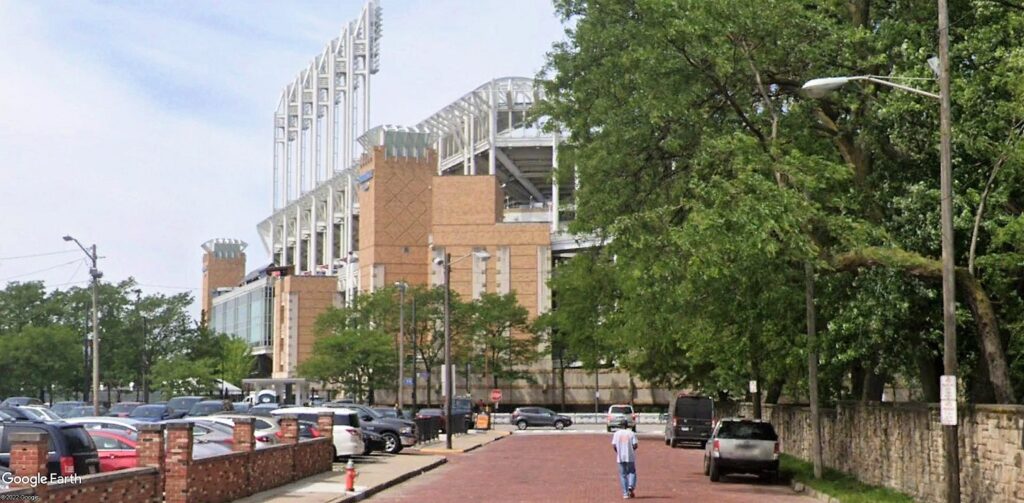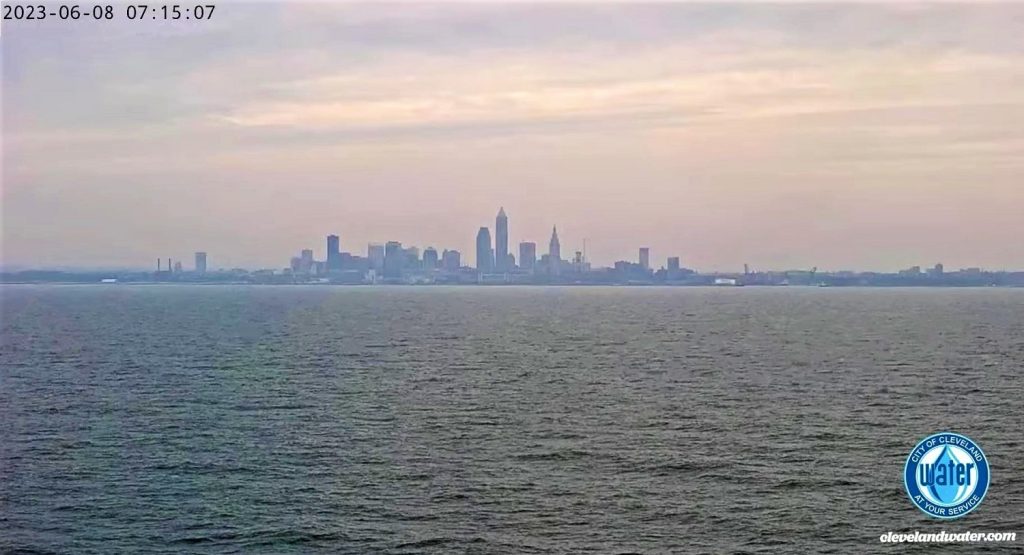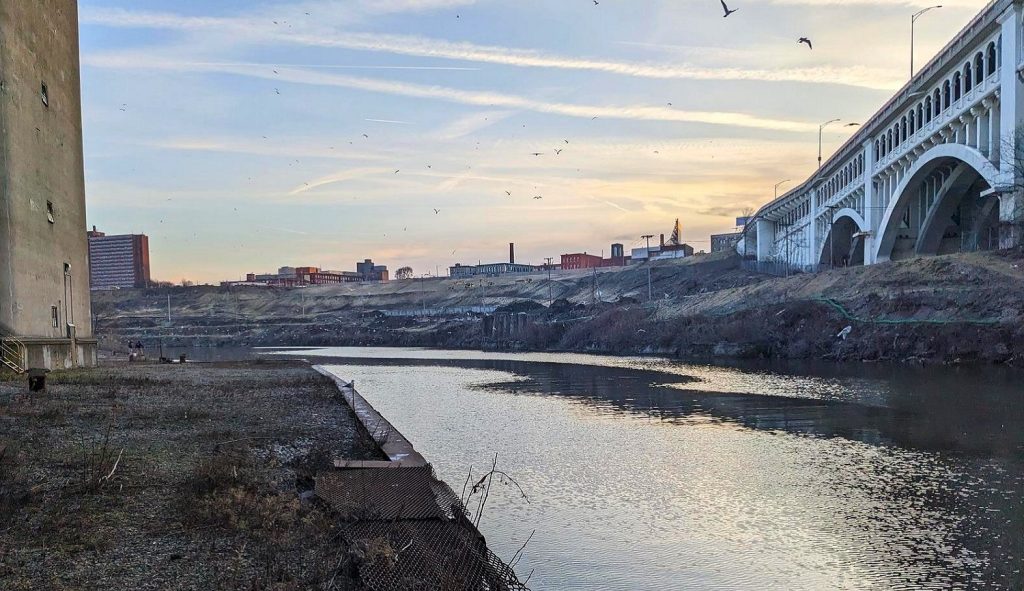
Before there can be an Irishtown Bend Park, there has to be a stable hillside above the Irishtown Bend in the Cuyahoga River. Crews have been working since late-summer 2023 to re-grade the hillside with a more gentle slope. Soon, a steel bulkhead along the water’s edge will be installed from a barge partially blocking the navigable waterway almost daily for more than a year (Jordan Abbott). CLICK IMAGES TO ENLARGE THEM.
Bulkheads to be installed along Cuyahoga River
In the coming weeks, the U.S. Coast Guard is expected to establish safety zone requirements for the barge-based installation of steel-wall bulkheads along the edge of the Cuyahoga River at Irishtown Bend in Cleveland. Those requirements will likely result in the daily closure of the river channel to commercial shipping for hours at a time but leisure and recreational boating is not expected to be significantly affected.
That’s the word from maritime stakeholders and the Cleveland-Cuyahoga County Port Authority which is administering the $60 million stabilization of the hillside above Irishtown Bend. And the shipping and boating interests who use the Cuyahoga River for business or pleasure said they have collaborated on guiding the proposed schedule of daily closures of the river channel to large commercial ships. The closures could continue for more than a year.
But rumors that the Cuyahoga River would be completely closed to all ships and boats for months on end are not true, officials said. Instead, at this time, it looks as if the river will be opened and closed on a daily basis with no work done on weekends and thus no closures. It will be on a schedule to be determined by the Coast Guard and permitted by the Army Corps of Engineers.
“Shipping on the Cuyahoga will not be closed,” said Port Authority President & CEO William Friedman. “The contractor is working with navigation stakeholders to determine the best method for installing the bulkhead while keeping shipping traffic moving. The port places the highest priority on uninterrupted shipping to the steel mill and other maritime-dependent industries. Which is, after all, the reason for the stabilization along with ensuring the safety of people and other critical infrastructure in the vicinity of the hillside.”
As part of the 18- to 24-month hillside stabilization project for which ground was broken Aug. 25, 2023, more than 2,100 linear feet of steel bulkheads at the river’s edge will be installed. The work is being done to remove many tons of fill dirt placed on the clay hillside in the 1960s which now threatens it with catastrophic slope failure.
Slope failure risks blocking the river, a federal shipping channel upon which Cleveland’s $4.7 billion maritime shipping economy and 22,000 jobs depend, including steel manufacturing, asphalt production and aggregates shipping. That work must also be done before any construction can begin on a proposed $45 million Irishtown Bend Park. About $19 million is already in hand for the park. The hillside stabilization is fully funded.
Bulkheads at Irishtown Bend cannot be installed from land, unlike the bulkheads installed upstream at Collision Bend for Bedrock Real Estate’s riverfront developments, specifically the planned Cleveland Clinic Global Peak Performance Center. Those were installed by landside-based crews and equipment.
At Irishtown Bend, steel bulkheads to support the river’s banks and maintain a 23-foot-deep shipping channel will be installed from a 40-foot wide barge, said Share the River founder and Executive Director Jim Ridge.
There may also be in the river a “turbidity curtain” to catch suspended sediment 10 feet from the barge, he added. While the river channel is about 270 feet wide here, losing 50 feet or more of that for a Coast Guard safety zone will make the river too narrow for the big Great Lakes ships to get through, a shipping industry representative said.
“A safety zone requires us to stay out of the area,” said Eric Peace, vice president of the Westlake-based Lake Carriers’ Association which represents commercial shipping interests on the Great Lakes. “We can’t make that turn while they’re working. The Coast Guard will determine how long the closures will be, but they will probably be daily and for hours at a time, but I don’t know for how long. It will probably only impact commercial shipping. I don’t think it affects pleasure craft.”
Goettle Inc., a Cincinnati-based company with expertise in deep foundations, earth retention systems and marine construction, is the lead contractor on the hillside stabilization project. Subcontractors working on the bulkheads presumably will move the barge into position in the mornings to work at Irishtown Bend and then, at the end of the day, return the barge to an out-of-the-way location so the big ships can get through.
“The Coast Guard and Army Corps of Engineers have been doing a pretty good job at coordinating with us,” Peace said. “It will impact us but we’ll get through it.”
At least four times per year, a meeting is held by the Cuyahoga River Safety Task Force, comprised of maritime interests — port authority, steelmaker and shipper Cleveland Cliffs, other industrial shippers, plus Share the River, a nonprofit group that promotes the economic, recreational and social vibrancy of Cleveland’s waterfront along Lake Erie and the Cuyahoga River.
At its most recent meeting Feb. 8, river stakeholders learned about how the bulkhead work was going to be done. Ridge, a former US Navy man, said he had previously assumed the work would be done from land as Bedrock did at Collision Bend. He was surprised to learn it would be installed from a barge on the water, across the river from the Cleveland Rowing Foundation.
“We want to make sure they work in harmony with the users of the river which is about 1,000 people per week,” said Ridge. “We are as much an advocate for the commercial use of the river as the recreational use of the river. We are joined at the hip with the lake carriers. We all just get along on this narrow body of water.”
END

